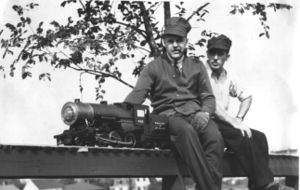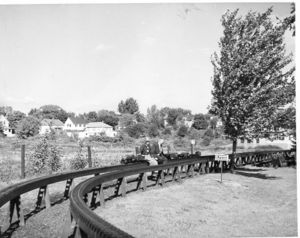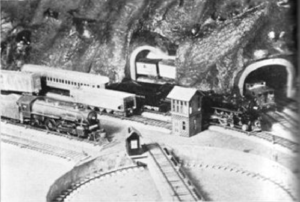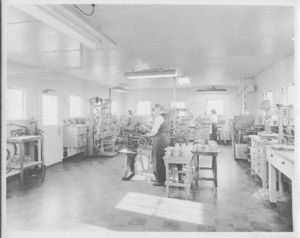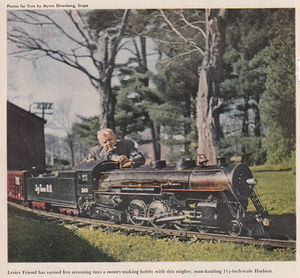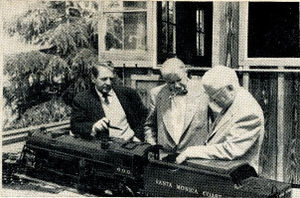Lester Friend: Difference between revisions
| Line 64: | Line 64: | ||
File:SouthBendLatheAdvert featuring LesterDFriend.jpg|South Bend Lathe advertisement featuring Lester D. Friend, from "The Live Steamer", May-June 1950 | File:SouthBendLatheAdvert featuring LesterDFriend.jpg|South Bend Lathe advertisement featuring Lester D. Friend, from "The Live Steamer", May-June 1950 | ||
File:LesterFriend Hudson True.jpg|Lester Friend with his 1.5 inch scale Hudson at Topsfield Fair. From "True", May 1951. | File:LesterFriend Hudson True.jpg|Lester Friend with his 1.5 inch scale Hudson at Topsfield Fair. From "True", May 1951. | ||
Joe Friend True May 1951.jpg|Joe Friend, Lester's son, from "True" Magazine, May 1951. | |||
</gallery> | </gallery> | ||
Revision as of 17:36, 24 August 2014
In July 1941, Lester Friend, President of the New England Live Steamers, paid a visit to Southern California, with the intent of getting the local live steamers to form a club. He met with Dick Bagley, Eddie Sargent, Kyle Testerman, Arthur "Bud" Stump, and C.S. "Stan" Chovil and in January 1942, The Southern California Live Steamers was formed with 35 charter members at Richard B. Jackson's backyard machine shop in Beverly Hills, CA. The membership elected Dick Bagley, chair; Dick Johnson, vice chair; Stan Chovil, treasurer; Bud Stump, secretary; and Ward Kimball, corresponding secretary.
History
By John Kurdzoniak, from Friends "Yankee Shop" Models:
The Friend Box Company was founded in 1884 by members of the Friend family, and did business at a factory in Danvers, Massachusetts (about 20 miles north of Boston, in Essex County), making rigid cardboard boxes such as jewelry boxes, cigar boxes, etc.
Lester Danforth Friend (also known as "L.D. Friend" and even just "L.D.F.") was born in 1895, and probably entered "the family business" as a teenager or as a young man. He served in World War I, and met Walt Disney sometime during the War. They were lifelong friends from that point on.
By the 1930s, it appears as if Friend Box Company was wholly-controlled by Lester Friend. Every story I've ever heard, from those who knew him, says that Lester Friend "owned" the box factory (but whether he was its President, or a major stockholder, or its "owner", is no longer known by any living members of the live steam hobby, as those who knew, are all deceased). Regardless of what position he held, Lester was "the boss" at the box company. (The Friend Box Company is still in business today, but is no longer owned by the Friend Family.
Classic Live Steam of Yesteryear
Our History: 1938-1972
The Friend Box Company was founded in 1884 by members of the Friend family, and did business at a factory in Danvers, Massachusetts (about 20 miles north of Boston, in Essex County), making rigid cardboard boxes such as jewelry boxes, cigar boxes, etc.
Lester Danforth Friend (also known as "L.D. Friend" and even just "L.D.F.") was born in 1895, and probably entered "the family business" as a teenager or as a young man. He served in World War I, and met Walt Disney sometime during the War. They were lifelong friends from that point on.
By the 1930s, it appears as if Friend Box Company was wholly-controlled by Lester Friend. Every story I've ever heard, from those who knew him, says that Lester Friend "owned" the box factory (but whether he was its President, or a major stockholder, or its "owner", is no longer known by any living members of the live steam hobby, as those who knew, are all deceased). Regardless of what position he held, Lester was "the boss" at the box company. (The Friend Box Company is still in business today, but is no longer owned by the Friend Family.
In 1938, Lester built the New England Live Steamers track on the property behind his box factory. It was a 2-1/2" and 3-1/2" gauge elevated ("highline") loop of track some 600' in length that went out to the bank of the Porter River, a tidal marsh, and then returned. On its return, it crossed a "high trestle" over part of the tidal marsh. This "High trestle" was about 8 feet off the ground.
Charlie Purinton, the son of Brotherhood of Live Steamers founder Charles A. "Carl" Purinton (1898-1999), has told me (John Kurdzoniak) that he and some local live steamers of the era (and several of Lester Friend's employees of the box company) helped to build the NELS Danvers track, and that it was built in less than a month! Charlie was 16 years old at the time.
O Gauge Layout
From "The Model Railroader", page 422, date unknown.
North Mountain RR.
Hardest Problem Tacked First, Building an O Gauge Live Steam Loco.
By L.D. Friend
My first trial in model railroading was, I believe, a tremendous jump, as I started in by building a 1/4-inch scale live steam pacific, using Birch castings. To the surprise of myself, as well as my friends, it ran with spool valves and all. In fact, it operated so well that I was able to load 50 odd pounds of dead weight iron behind it, sticking a flat-iron on top of the seam dome for added traction to keep the drive wheels from spinning. She would take off as nicely as the prototype.
After completing my live steamer, I found it very bothersome to start this up every time one of my friends wished to see the railroad run. So I decided to construct my road for dual operation, both electric and steam.
Gondolas, hopper cars, box cars, reefers were the next attempt, of which I have now all told eight cards with a crummy. Not being satisfied with the conventional straight railroad which ran around on benches, I included in my plans mountains, grades, bridges and culverts, with the result that I now have completed three mountains, three tunnels, a cut through a ledge and about 220 ft. of completed track, rock ballasted, with electric switches and whatnot.
The roundhouse is practically completed. The turntable is finished with the exception of motorization. The control panel is a maze of buttons. The road requires a bit of ingenuity to operate, with its eight electric and five manually operated switches, automatic reverse and sectional cutouts.
All of this is in a room set aside in my basement with a total area of about 25 x 11 ft. and of course on benches that are 36 inches from the floor. The benches have all been made so that as I construct my valleys, fields, etc., I may use regular sand and it will not fall through the benches to the floor.
I am now working up a system, nearly completed, for individual lighting, as I have found that a large ceiling bulb for lighting detracts value from the railroad. Indirect lights with very small bulbs in and around the depots. Layered trees improve the perspective greatly.
I expect it will take another year to complete the scenic effects of the North Mountain RR., and then I expect to start on a 3/4-inch scale steamer which has always been my dream.
Yankee Shop
Traveling Ambassador
Lester described a trip he made to California in The Miniature Locomotive, November-December 1952 edition.
Your Traveling Live Steam Abamassador
The Miniature Locomotive, November-Decmeber 1952
(Second Section of Article)
After spending a long evening with Dick and Mrs. Bagley, his very efficient and helpful wife, also with the printer, Mr. Hungerford, I knew immediately that the magazine was going to be a success.
Next came a very fine visit at Dave Rose's, our nationally known musician and orchestra leader. Dave is proud as all get-out of his road, his engines and his museum. I was very much surprised to find what a tremendous collection of stationary steam engines and also steam locomotives of many ages that he has in his museum. It would really take one many hours to study and appreciate it. Following a fine visit at Dave's at which we, of course, steamed up and operated on his 1-1/2 inch scale road, we lunched with Brother Walt Disney.
Apparently, while we were lunching, Roger Broggie, was steaming up that beautiful 1-1/2 inch scale Old Time of which Walt is so proud. We spent the entire afternoon riding, looking, and talking 1-1/2 inch scale and may I say here that your good friend Walt Disney, has probably the most outstanding 1-1/2 inch scale road operating in this country. Everything is to detail, everything is to scale, remote switches, control board in the little old barn which he loves, even to the self-operating telegraph which is sending out messages continually. This board was given to Walt by some of his employees at the studio. The whole road, tunnels, bridges, and track work, is simply breath-taking. My eleven-year-old son Walter, I don't think got off the train. They merely shifted engineers from time to time until finally the afternoon wore away.
Then came a coalition with Dick Jackson the host and may I say for Dick, knowing him for many years, that he certainly has been the godfather of live steam in the Los Angeles area with his home and his railroad in the back yard, always anxious to welcome the Los Angeles group for a grand time. His workmanship on the depots, the hand-car, the little water tank, turntable and many other things that I can't think to mention, is of the highest quality. Smiling Dick Jackson -- always ready to greet you and invite you to operate his road. I recall in 1940 that it was his salesmanship that finally broke Mrs. Friend (Julie) down and she operated Dick's engine as the first engine she had ever operated in her life. Imagine this when I had been trying to get her to operate in her years with no success but, "Smiling Dick" put it over. At Dick's house the entire Los Angeles group, Southern California Live Steamers, were invited to visit, see movies, and talk live steam and rub elbows with the brother live steamers. I spoke to the group trying as best I could to inform them of what was going on in the Eastern and Central areas pertaining to live steam. I found them a very splendid and receptive group of brothers.
The visit to Lomita came next where the S.C.L.S. were having a grand time operating in that California sunshine. We met Irene Lewis for the second time and spent a very enjoyable hour chatting with her on problems of live steam. This track, which the brothers were operating on, was recently constructed and certainly is a fine piece of workmanship. They are still adding and building more to it and it promises to be a real hot spot for the live steamers of that area and with Irene the hostess, as she is on many occasions, I can see that live steam will go forward in leaps and bounds.
Following this we visited Bob Day, of The Miniature Locomotive magazine. His 1 inch scale road is growing like the beautiful array of flowers around it. His plans call for a very extensive system in 1 inch scale and his beautiful locomotive, which is too heavy to lift, sets on a turntable which is also a hydraulic lift. Turn a valve and it rises up six feet and rolls into his shop window right on the shop bench. I have stated many times that men will spend two or three thousand hours building a locomotive and then beef around about how hard it is to pick up and move. After all, if one would spend just on more day in concocting an elevator or lift for the engine there would never be any difficulty in lifting or sore backs.
Bob certainly has a fine engine lift which recalls to my mind that Dan Kelly of Seattle, Washington, has the same thing, hydraulic lift with the ordinary domestic water pressure. The simplest thing in the world -- two pipes with a rail on top, two valves and you have your lift plus the fun of operating it. You can look forward in the future to seeing Bob Day's railroad growing to a beautiful railroad system. Those are the kind of fellow we like to have behind the magazine.
At Ollie Johnson's we had another fine visit on a 1 inch road which is growing like an irrigated weed. his plans too call for large expansion, beautification, bridges, tunnels and all that goes with a good 1 inch scale railway system. Only recently LIFE magazine photographed the Southern California brothers with their engines at Ollie Johnson's railroad.
Then came Ward Kimball, that amusing fellow who not only has a collection of three foot gauge railroad equipment but also fire engines and other fire equipment as well. There you can really climb up into them, fell the throttle, ring the bell, blow the whistle and roll along on his 3 foot gauge with delight in your heart. Ward is reclaiming a half dozen pieces of narrow gauge equipment which to me seems like a lifetime job but he says that the boys give him a hand and they really move along when they get going. His fire kit, of course steam, is all polished up and brought to its original shape as when brand new. I can imagine the many hours spent on these laborious tasks of reclaiming fire engines. How Ward finds time to play with the "Fire House Five" (Plus 2) orchestra, no one can tell but it certainly is a "hot" band and really worth listening to. Whereas I am a trumpeter in our own Rotary Orchestra I was greatly interested in Ward's efforts in his musical group. I certainly enjoyed hearing a couple of records and also appreciated a gift of half a dozen more.
I neglected to say, as I have told you of these different travels, that each night we would return to Dick Bagley's house to talk about the magazine, discuss the pitfalls, the advantages and the success that we hoped to gain amongst the live steamers.
Many of the minor details in Los Angeles are not too important so we'll skip those. We soon boarded the Super Chief headed East in which Walter spent most of his time in the astrodome enjoying the fine facilities of the train, then to Chicago, the New England States via the New York Central's home.
However, we were not home for long before we started off to make a visit with the Pennsylvania Live Steamers out at Ken Souser's home in Paoli, Pennsylvania. Here George Thomas, Percy Pierce and many others showed up for the movies which I had taken in the West of the California live steamers and a fine chat once again on the success of The Miniature Locomotive magazine. We found that each and every Pennsylvania live steamer was willing to ake it upon himself to be a go-getter for subscriptions to The Miniature Locomotive. We found the club track in Ken Souser's orchard in very fine shape. It is really a fine piece of workmanship and something the P.L.S. can be proud of. It is now in three gauges, 2-1/2 inch, 3-17/32 inch and 4-3/4 inch. They like to have visitors come to their meetings and bring their engines so have this in mind when traveling through this area. Contact Percy Pierce, 426 Greenview Lane, Llanerch, Pa., who is a very live secretary as well as live steamer.
Generally, the Pennsylvania Live Steamers are going ahead by leaps and bounds, fine engines amongst the group and fine interest.
Next stop was at B. Hunt Smith at Llewelyn Park, W. Orange, N. J., where I just missed an operating meet by four days as Hunt had had the whole gang on his private loop for a grand party. However, he informed me that the N.Y.L.S. were doing well and that their road in Long Island, N. Y., was operating at least twice a month with fine interest. Hunt has finished his 3/4 inch scale engine.
Once again I feel that my trip to the West Coast, for the express purpose of helping in any way possible toward the success of The Miniature Locomotive by contributing knowledge or ideas to their cause plus moral support, was well worth the expense. I hope all live steamers throughout the country will encourage their friends to subscribe and by doing so stand back with pride and say, "We now have the magazine we were looking for."
At Bob Day's home, left to right are Dave Rose, Les Friend, Dick Jackson and Bob Day. In the background is the Engine House. The locomotive is on the hydraulic hoist used to lift it from ground level to bench top in house. The hoist also serves as a turntable. From "The Miniature Locomotive", Nov-Dec 1952.
